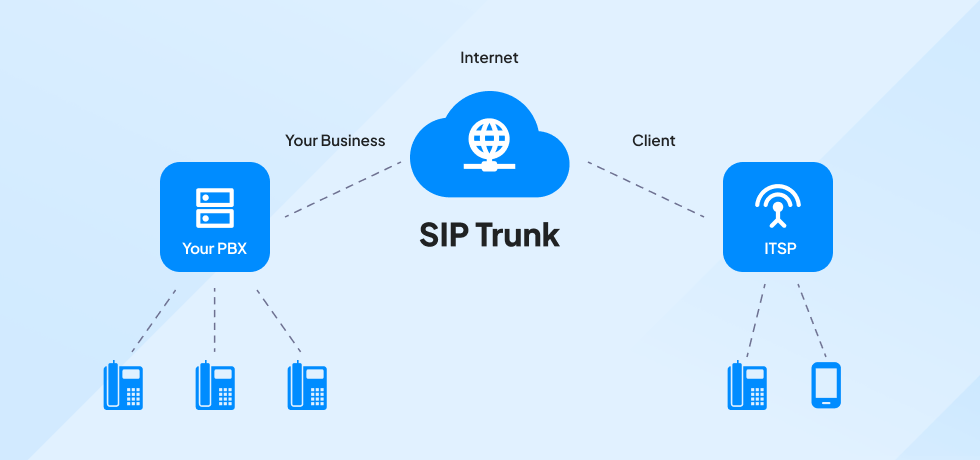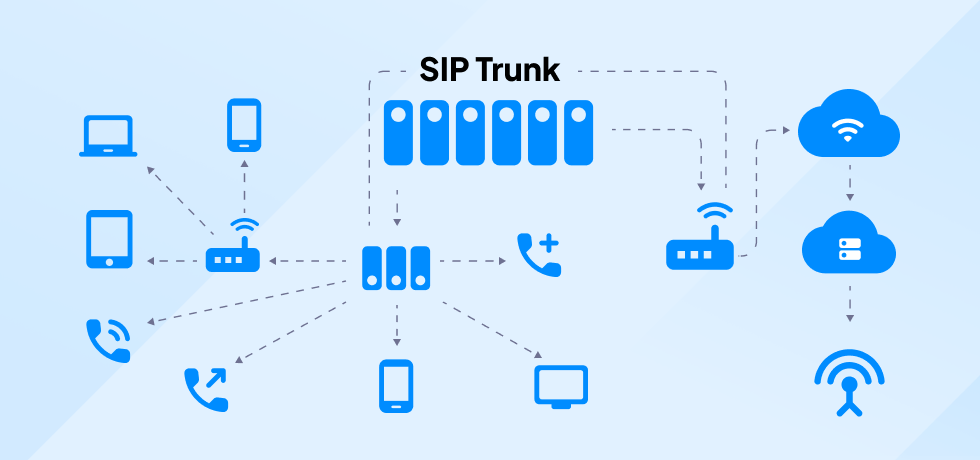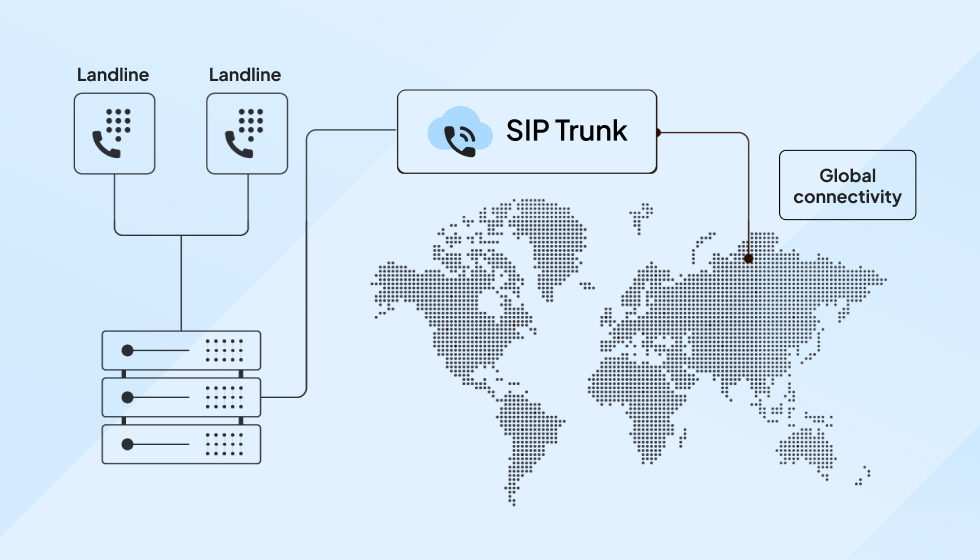
The global shift away from traditional phone systems in the telecommunications sector is significant. By 2025, analog telephone lines are expected to disappear, pushing businesses to transition towards internet-based and mobile communication platforms.
As this shift continues, SIP trunking emerges as a pivotal technology facilitating the move to internet-based and mobile communication solutions. This transition modernizes communication infrastructures and offers enhanced flexibility, scalability, and cost savings.
Read on to learn how implementing SIP trunking can transform your business communication systems, making your operations more efficient and connected than ever.
What is SIP Trunking?
SIP trunking, or Session Initiation Protocol trunking, is a method of sending voice and other unified communications services over the Internet. It works with an IP-enabled PBX (Private Branch Exchange), a private telephone network used within a company.
SIP trunks replace traditional telephone lines or PRIs (Primary Rate Interfaces), allowing businesses to communicate using voice-over IP (VoIP) technology directly from their PBX to the global telephone network.
SIP Trunking can seamlessly integrate with Communications Platform as a Service (CPaaS), offering businesses a comprehensive and flexible communication solution.
How does SIP Trunking work?
Here’s a simplified overview of how SIP Trunking transitions call from traditional systems to VoIP:
Traditional phone systems
- Analog and digital lines: Traditional phone systems, also known as Public Switched Telephone Networks (PSTNs), connect calls using analog lines (for smaller setups) or digital T1/E1 lines (for larger systems). These systems require physical wiring and exchange systems to route calls.
- PBX (Private Branch Exchange): Larger businesses use a PBX to manage inbound and outbound calls within their organization and to the outside world. A PBX allows for call transferring, voicemail, call queues, and more, but traditionally, it’s connected to the PSTN using physical lines.
Transition to VoIP and SIP Trunking
- IP-PBX: To use SIP Trunking, businesses typically need an IP-PBX, a PBX system capable of handling VoIP calls. IP-PBX systems can convert traditional voice signals into digital format and route calls over the Internet.
- SIP Trunking: SIP (Session Initiation Protocol) Trunking is the standard for initiating, maintaining, and terminating real-time sessions that include voice, video, and messaging applications. SIP trunks connect the IP-PBX to the internet.

- Call initiation: When a user makes a call, the IP-PBX converts the voice signal into digital packets and sends a SIP request to establish a call session.
- Routing over the Internet: The SIP trunk routes these digital voice packets over the Internet to the SIP provider.
- Connecting to the destination: The SIP provider connects the call to the recipient, which could be another VoIP user or a number on the traditional PSTN. If the call is to a traditional phone number, the SIP provider converts the VoIP call back into a traditional phone signal before reaching the recipient.
- Call management: Throughout the call, SIP protocols manage the connection, adjusting for quality and ensuring that data packets arrive in the correct order. SIP can also handle call transfers, conference calls, and other features.
- Termination: Once the call is finished, the SIP protocol terminates the session, and the IP-PBX closes the connection.

SIP vs VoIP: What’s the difference?
SIP and VoIP are interconnected technologies, yet they differ significantly. SIP offers a more comprehensive technology framework than VoIP, supporting a wider range of communication types.
For more clear details on how these technologies compare, please see the table below:
FeatureSIPVoIP
| Scope | Broader, capable of initiating interactive sessions | Narrower, focused on voice transmission |
| Functionality | Supports voice, video, and other multimedia services | Transmits voice calls over the internet |
| Supported Services | Voice calls, video conferencing, messaging | Voice calls |
| Primary Use | Initiating and managing multimedia communication sessions | Making voice calls via the internet |
What is SIP Trunking used for?
SIP Trunking is a modern replacement for traditional PRI technology, which has been the backbone of voice and data delivery over physical copper lines for many years. PRI (Primary Rate Interface), essentially consolidates multiple analog phone lines into a single bundle, yet it incurs high maintenance costs due to rapidly aging hardware.
Leveraging VoIP technology, SIP Trunking transcends these limitations by facilitating voice communications and supporting data transmissions such as instant messaging and video conferencing.
This makes SIP Trunking an economically efficient and versatile option for businesses seeking to upgrade their communication infrastructure without straining their budgets.
Indicators your business is ready for SIP Trunking
To determine whether your company is poised to transition to SIP Trunking, consider the following:
- Underutilized call capacity: Are you overspending on-call capacity you rarely use?
- Costly equipment maintenance: Is the financial burden of maintaining your current communication equipment becoming unsustainable?
- Call reliability concerns: Are you experiencing frequent call drops or seeking overall improved call reliability?
- Flexible workforce needs: Do you employ remote workers or have staff that frequently travels or relocates?
If the answer to these considerations is yes, it might be time for your company to embrace SIP Trunking. This transition can significantly reduce overheads related to unused call capacities and equipment maintenance while also enhancing call reliability and supporting a flexible, modern workforce.
Moving to SIP Trunking addresses these critical operational efficiencies and positions your business for scalable, future-ready communication solutions.
Benefits of SIP Trunking
SIP trunking is ideal for businesses of all sizes, ranging from sole proprietors and small enterprises to large multinational corporations with extensive global operations.
Whether you currently make many calls or anticipate an increase in call volume, SIP trunking can provide numerous advantages for your business.
Cost savings
SIP trunking reduces the need for physical phone lines, lowering maintenance costs and call charges, especially for long-distance and international calls.
Furthermore, the pricing for SIP trunking services is straightforward, often charged per-user. Typically, the cost structure for SIP trunking includes:
- An initial setup fee
- A monthly fee for the broadband service
- A per-channel rate, which might come with an included call allowance
- Charges for the actual calls made
Scalability and flexibility
SIP voice and data services offer rapid scalability, granting businesses unparalleled flexibility for expansion. This is particularly advantageous for companies aiming to extend their reach across various regions or increase their remote employees.
SIP trunking simplifies the integration of offices and remote workers by merging voice and data services into one network. Adjustments to user numbers and bandwidth, in line with shifting business requirements, can be made smoothly, minimizing risks and avoiding unforeseen expenses.
Enhanced features
SIP trunking goes beyond traditional voice services by supporting various advanced communication features. This technology enables businesses to conduct video calls, send instant messages, and engage in multimedia sessions, all utilizing the same internet connection.
This multifunctionality is particularly beneficial in today’s digital workplace, where collaboration and communication demands are increasingly complex and varied.
Improved reliability
Disruptions in communication services significantly threaten business continuity. Although conventional phone services are well-known for their faults, it’s a common misconception that internet telephony suffers similarly.
In contrast, SIP trunking offers a robust backup solution during power outages or system malfunctions. It seamlessly redirects calls to mobile devices or alternate locations through your SIP provider. This failover feature ensures operational continuity, offering a level of reliability that surpasses traditional PRI phone systems.
Increased business productivity
SIP trunks pave the way for Unified Communications as a Service (UCaaS), enabling providers to consolidate a wide range of communication tools, such as video conferencing, instant messaging, collaboration applications, and voice integrations, onto a single, streamlined platform.
Centralizing real-time communication in one location facilitates a smooth interaction among employees and offices, significantly enhancing efficiency and productivity.
How to implement SIP Trunking
Implementing SIP trunking can revolutionize your business communications. Here’s a comprehensive guide on how to roll out SIP trunking effectively.
Prepare your network for SIP Trunking
- Assess network capacity: Evaluate your current network infrastructure to ensure it can handle the increased data load SIP Trunking will introduce. Pay special attention to bandwidth availability.
- Quality of service (QoS): Implement QoS on your network to prioritize voice and video traffic. This ensures clear and uninterrupted communication.
- Secure your network: Enhance security measures to protect your SIP Trunking setup. Consider firewalls specifically designed for SIP that can handle NAT (Network Address Translation) and allow for secure SIP traffic.
- Compatibility check: Ensure your existing hardware, like routers and switches, are compatible with SIP Trunking. You may need to update firmware or replace outdated equipment.

How to choose a SIP Trunk provider
When deciding upon a SIP Trunk provider, looking beyond basic cost and reliability considerations is important. Here are additional factors that can influence your decision and ensure you select a provider that aligns with your business needs:
- Geographic coverage: A provider’s ability to offer services in your desired locations is paramount, especially if your business operates across multiple countries or regions. Make sure the provider has a strong network presence in all geographic areas where you need service to avoid potential connectivity issues.
- Local number availability: Access to local numbers is essential for businesses looking to maintain a local presence. Check if the provider offers local Direct Inward Dialing (DID) numbers in your required areas. This enables you to offer local contact numbers to your customers, enhancing their trust and your company’s accessibility.
- Vendor consolidation: Working with a single provider for voice, data, and other communication services can simplify management and potentially reduce costs. Consider whether a provider can be a one-stop shop for all your communication needs, including SIP Trunking, cloud services, and unified communications.
- Reliability: Look for SIP Trunk providers with a proven track record of uptime and robust disaster recovery plans.
- Cost and scalability: Compare pricing plans. Consider setup fees, monthly rates, and costs for additional features. Your chosen SIP Trunk provider should also offer easy scalability options to accommodate business growth.
- Customer support: Look for providers that offer 24/7 support with multiple channels for contact, such as phone, email, and chat. Additionally, consider providers that integrate with Contact Center as a Service (CCaaS) solutions, enhancing your ability to manage customer interactions seamlessly across platforms.
- Features: Consider the range of features offered, such as call forwarding, automatic call distribution, voicemail to email, and compatibility with unified communications platforms.
- Security measures: SIP Trunk providers should have robust security protocols, including encryption and secure SIP, to protect your communications from interception or attack.
- Contract flexibility: Review the terms of service for flexibility. Short-term contracts or pay-as-you-go options provide freedom to change providers if your needs evolve without incurring penalties.
How to install a SIP Trunk: A step-by-step guide
- Sign up with a provider: Once you’ve chosen a provider, sign up for their service. You’ll typically need to provide some basic business information.
- Configure your SIP Trunk: Your provider will provide the necessary details to configure your SIP Trunk, including the SIP domain, usernames, and passwords.
- Connect to your PBX: Integrate the SIP Trunk with your existing PBX. This might require entering the configuration details into your PBX’s management interface.
- Test the connection: Make test calls to ensure everything is set up correctly. Check for call quality, latency, and feature functionality.
- Go live: Once testing is complete and you’re satisfied with the setup, you can start using your SIP Trunk for daily communications.
Conclusion
In summary, SIP Trunking presents a valuable opportunity for businesses across the spectrum. With its potential for reducing costs, offering greater adaptability, and delivering superior call clarity, adopting SIP Trunking is a logical move for modern enterprises aiming to optimize their communication strategies.
Related articles
What is number porting? Pros, cons, and business considerations
Are you considering switching mobile providers but a...
SMS geofencing: What it is and how does it work
Geofencing is one of the latest technological advanc...
SOAP vs REST API for A2P messaging: Choosing the right approach
Application-to-Person (A2P) messaging has emerged as...
How to calculate customer health score and slash churn rates
Customer health scores are metrics that reduce custo...
4 Easy Gmail SMS integrations with Textmagic and Zapier
Gmail is Google’s free email service, offering users...




